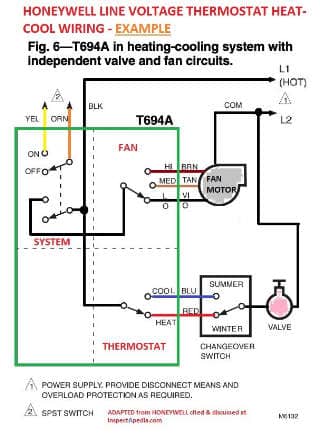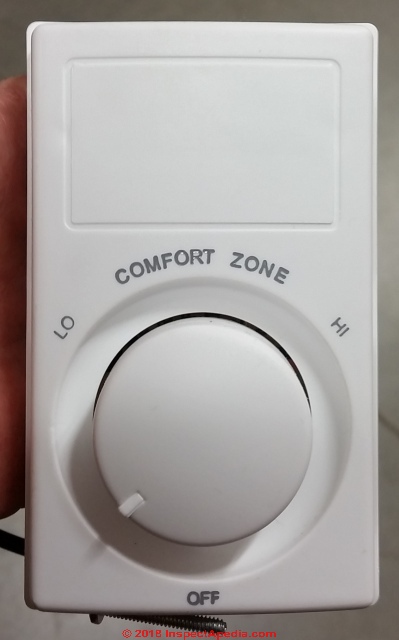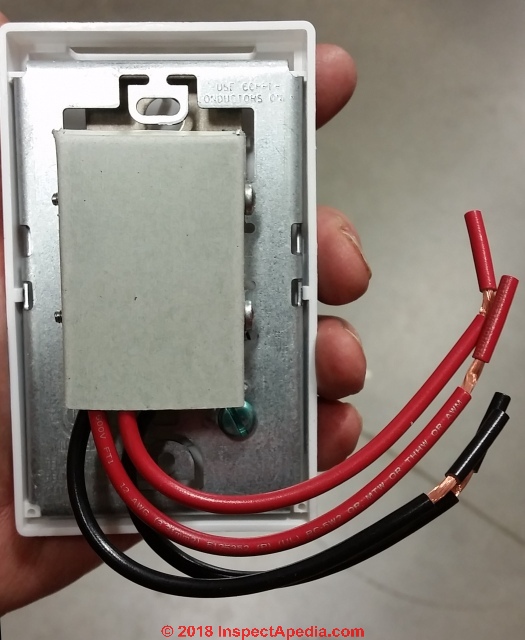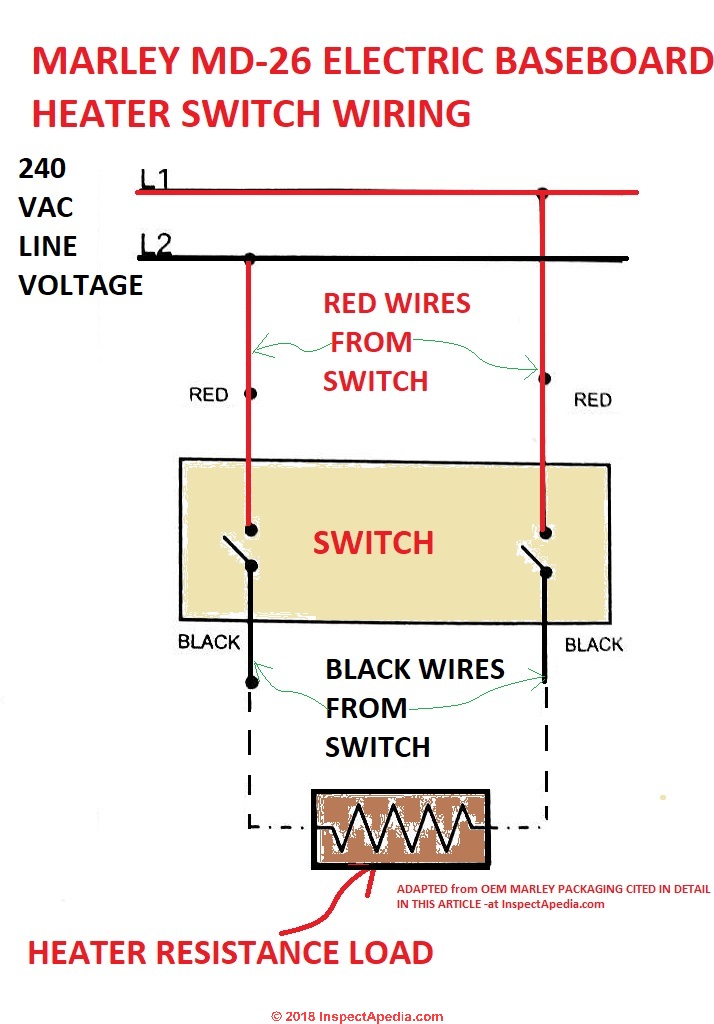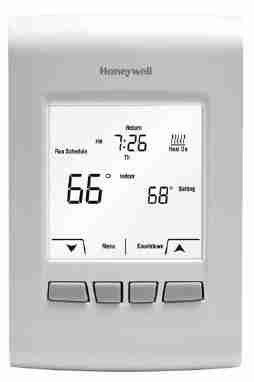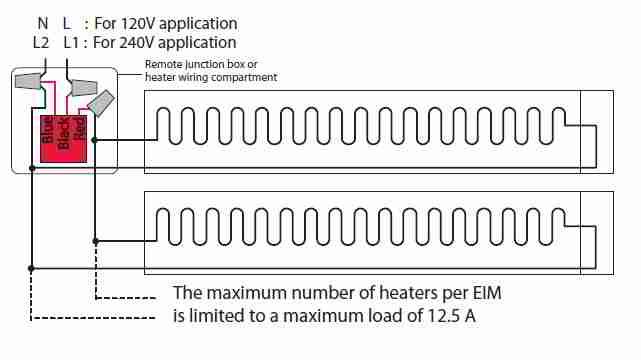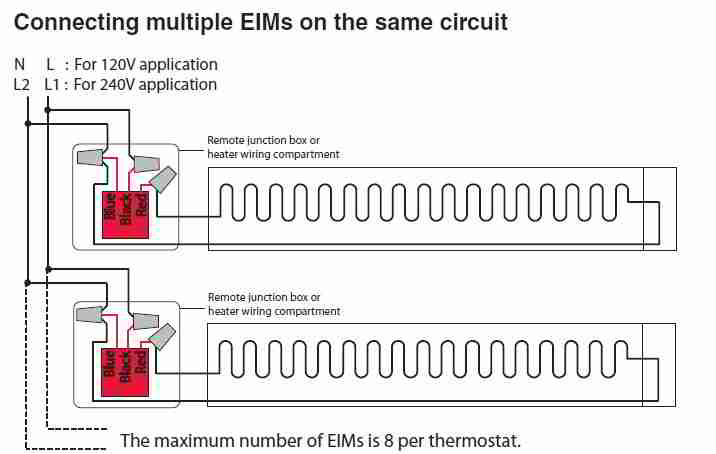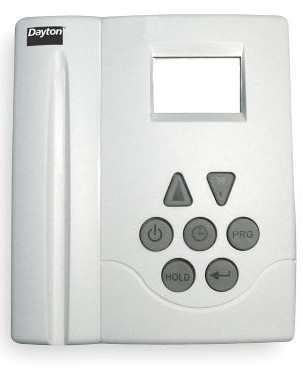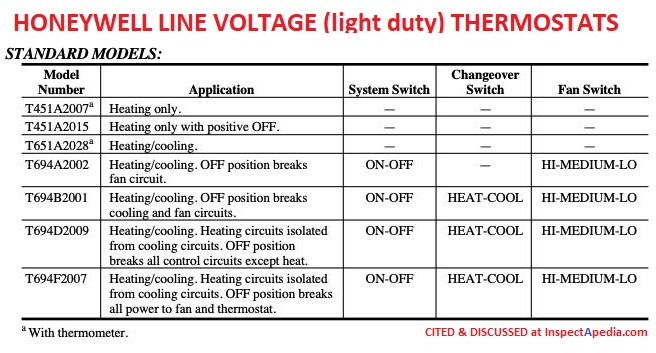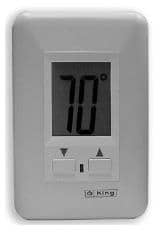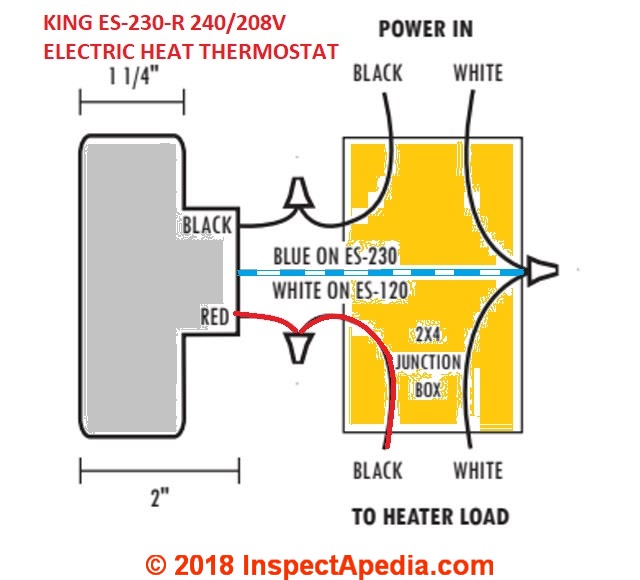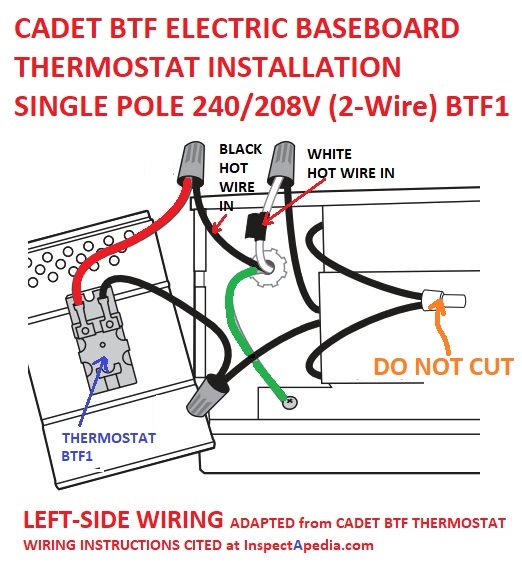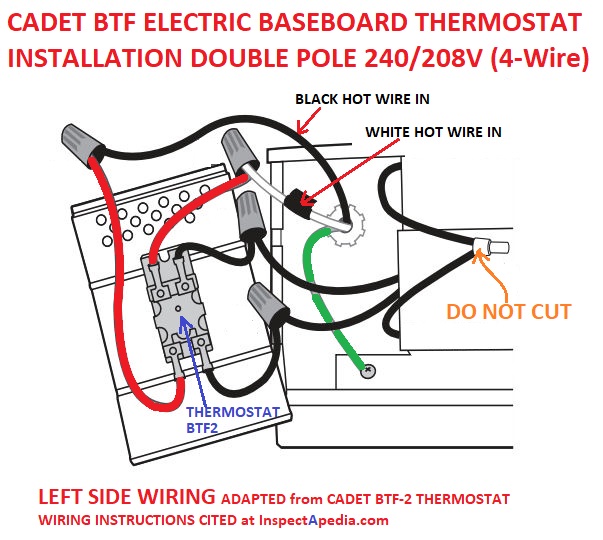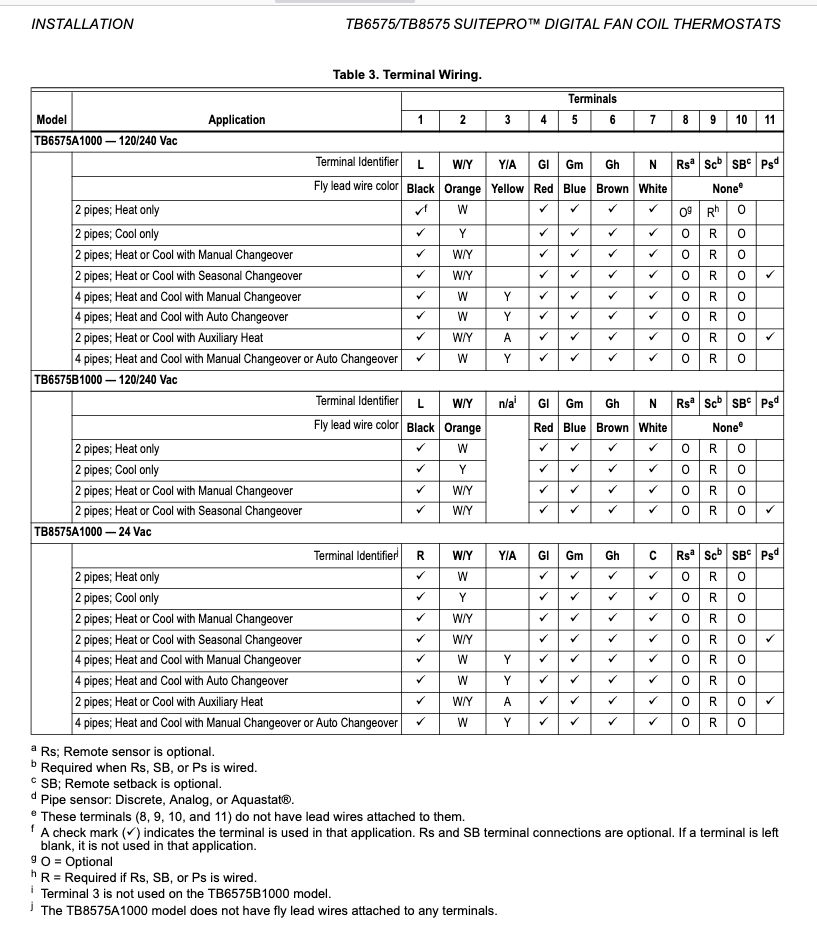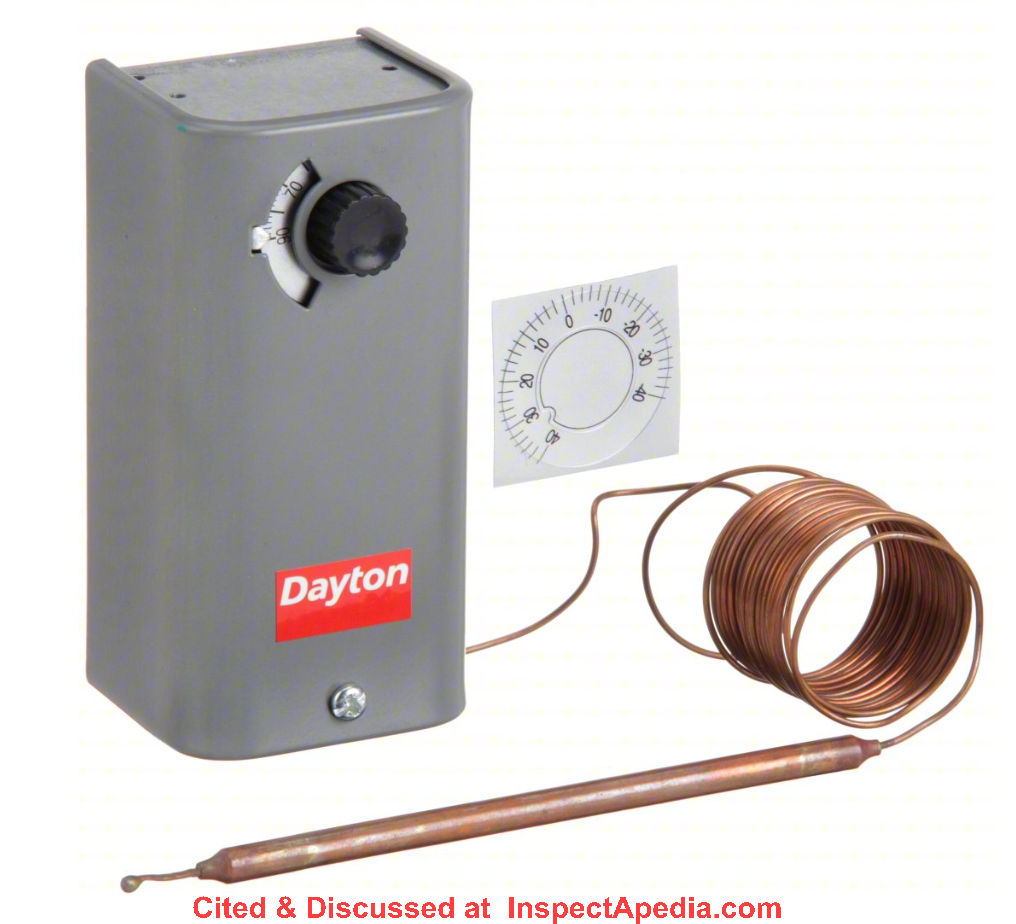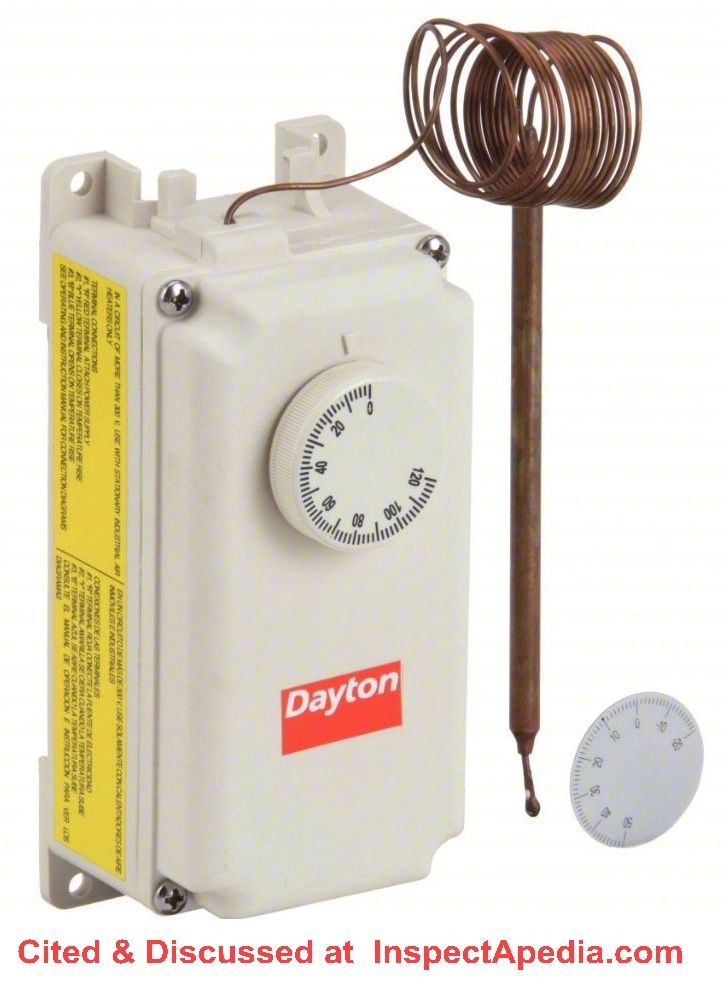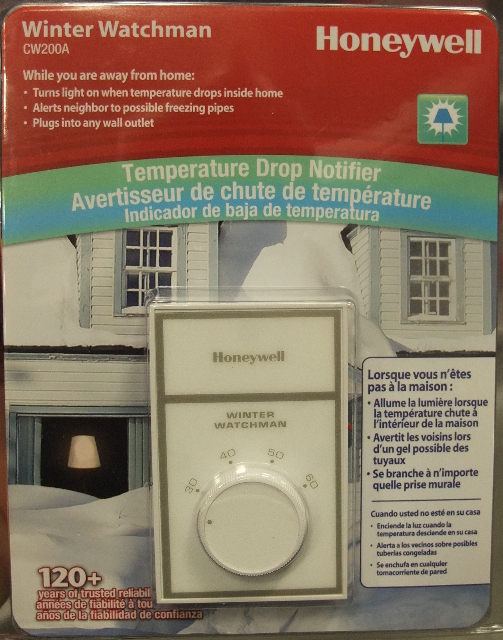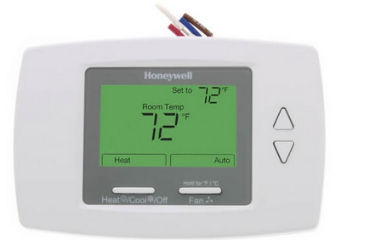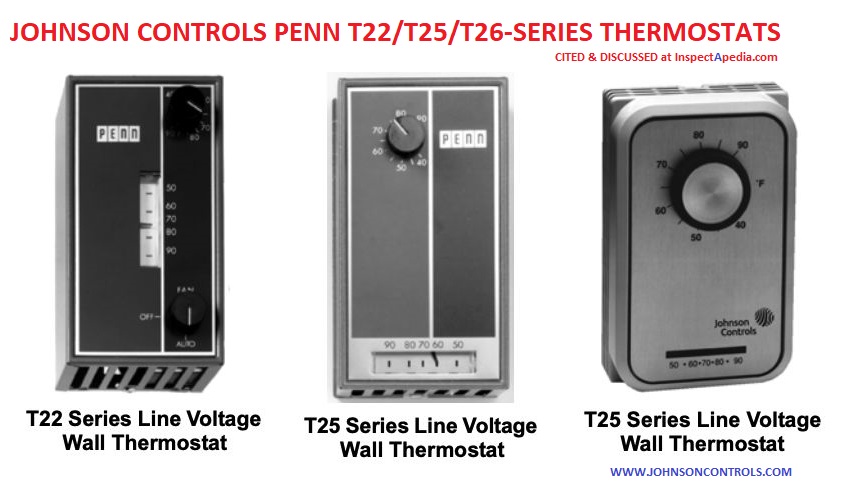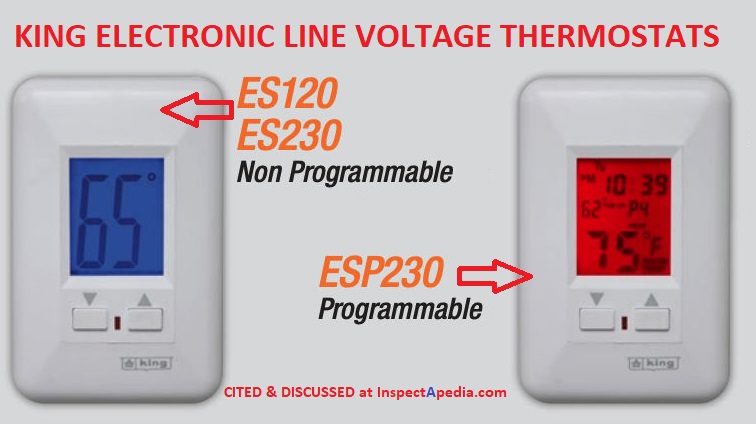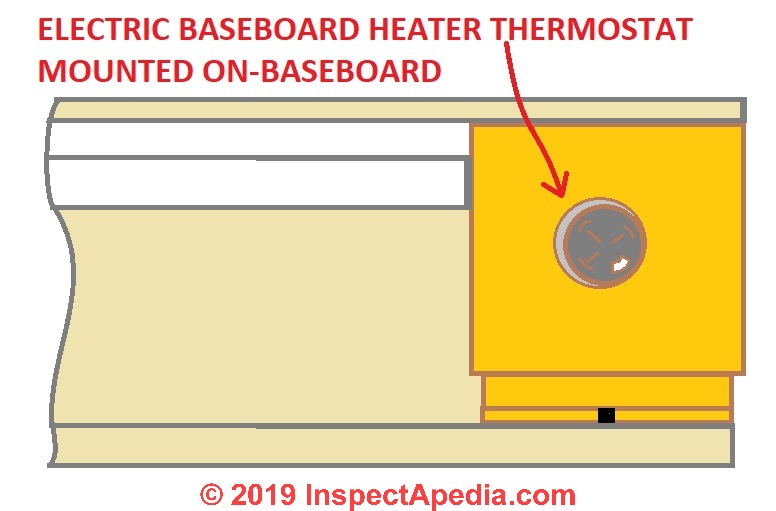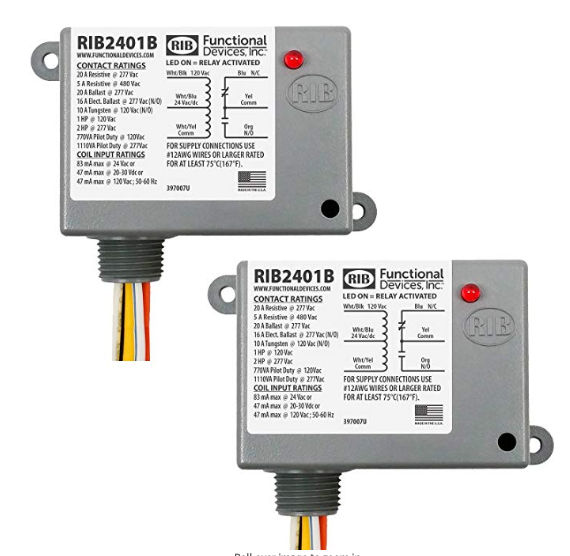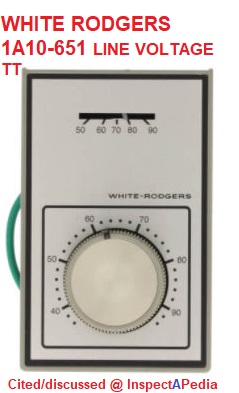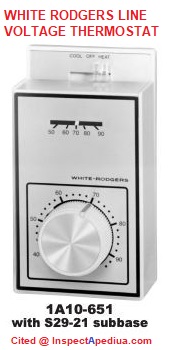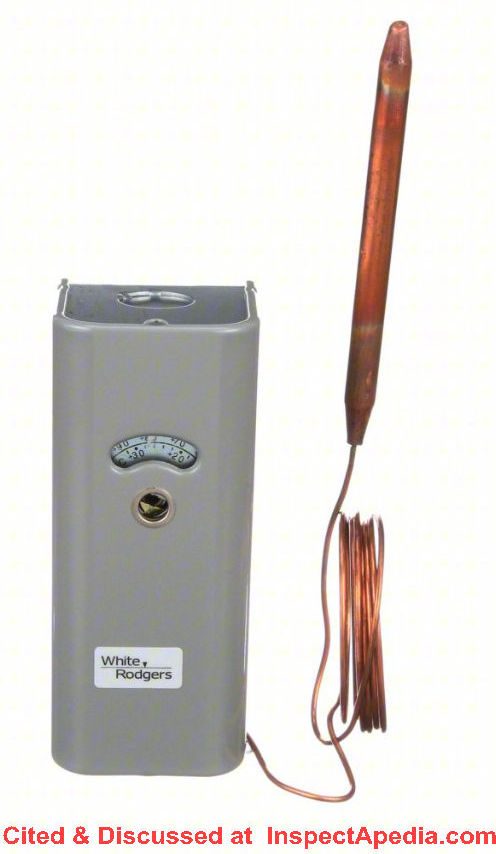 Line Voltage Thermostats for Electric Heating & Cooling
Line Voltage Thermostats for Electric Heating & Cooling
Install, troubleshoot, repair or replace a 120V or 240V thermostat used
- POST a QUESTION or COMMENT about line voltage thermostats, how they are wired, how a line voltage thermostat works
Guide to line voltage thermostats 120V or 240V room thermostats for electric heat, fan heaters, radiant floor heat, convector heaters.
This article describes types of line voltage wall or floor thermostats used to control heating or heating & cooling equipment where switching of 120V or 240V devices is required.
InspectAPedia tolerates no conflicts of interest. We have no relationship with advertisers, products, or services discussed at this website.
- Daniel Friedman, Publisher/Editor/Author - See WHO ARE WE?
Line Voltage Thermostats: choices, wiring, repair, replacement
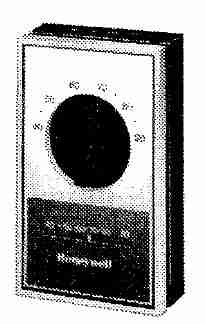 In this article we give examples of wiring instructions for both 120VAC and 230/240VAC electric heat thermostats, including both wall-mounted models and "built-in" electric baseboard heater thermostats that mount at either end of the electric heating baseboard itself.
In this article we give examples of wiring instructions for both 120VAC and 230/240VAC electric heat thermostats, including both wall-mounted models and "built-in" electric baseboard heater thermostats that mount at either end of the electric heating baseboard itself.
We list brands and models of electric heat thermostats including programmable and non-programmable models. To help you find a replacement thermostat for your original model we include manufacturer's electric heat thermostat cross-reference sheets.
Shown here: a drawing of an older classic Honeywell wall-mounted thermostat controlling electric baseboard heat. Here you'll find:
- WIRING 120VAC ELECTRIC BASEBOARD HEAT LINE VOLTAGE THERMOSTATS such as the Honeywell T451A, T651A, T694A,B,D,F
- WIRING a MARLEY ELECTRIC BASEBOARD HEAT THERMOSTAT
- WIRING a PROGRAMMABLE HEAT-ONLY LINE VOLTAGE THERMOSTAT
- WIRING a COOLING & HEATING CONVECTOR UNIT FAN THERMOSTAT
- WIRING a BUILT-IN THERMOSTAT on ELECTRIC BASEBOARD HEAT UNITS
- INSTALLING an ELECTRICAL RECEPTACLE "OUTLET" on AN ELECTRIC HEAT BASEBOARD
- LINE VOLTAGE THERMOSTAT INSTALLATION INSTRUCTIONS by BRAND & MODEL
How to replace & wire a Honeywell T451A electric-heat thermostat?
An InspectAPedia reader asked:
I have a two wire honey well thermostat T451A - I want to replace this thermostat with a programmable. Presently there is a two wire ( black and White ) 120 volt line; Any suggestions ? Thank you - M.S. 3/15/2013
Reply:
Watch out: Turn off power source to the heater before attempting installation, maintenance or repairs. Lock, tape or tag circuit breaker or fuse so that power cannot be turned on by accident. Failure to do so could result in serious electrical shock, burns or possible death. - King Electric cited below.
The Honeywell T451A room thermostat (illustration at left) is a line-voltage (120V) wall thermostat, a member of the product family including the T651 and T694 light duty line voltage wall thermostats.
These controls are widely used to directly control 120-V equipment such as valves, fans, motors, contactors, and electric heat systems as well as fan coil units in heating/cooling systems. Illustration at left of the Honeywell T415A and T651A from product literature. [4]
The T451 is a heat-only controller - I'm guessing yours may be controlling electric heat. I understand why you asked for help. Honeywell's own website includes a "thermostat finder" feature but is unable to give even one suggestion for a programmable line-voltage room wall thermostat. Happily the news is better than that.
Honeywell gives a succinct description of this class of wall thermostats:
Line voltage thermostats control the electricity directly, thus the name "line voltage." If you have a baseboard heater, electric wall heater, or resistive electric heater, you may require a line voltage thermostat. These thermostats are generally made for either 2 wires (SPST) or 4 wires (DPST - more common). ...
These are NOT to be used with gas heating systems (gas heaters are generally single stage systems). Most line voltage systems are mechanical rather than digital programmable, and are almost always either 2 or 4 wires.... [however there are indeed some programmable line-voltage thermostats available as we list below ] [5]
Honeywell's newer replacement for the T451 includes the Honeywell TH114 which is also non-programmable and NOT what you want.
Instructions for Wiring of Line Voltage 120V Wall Thermostats
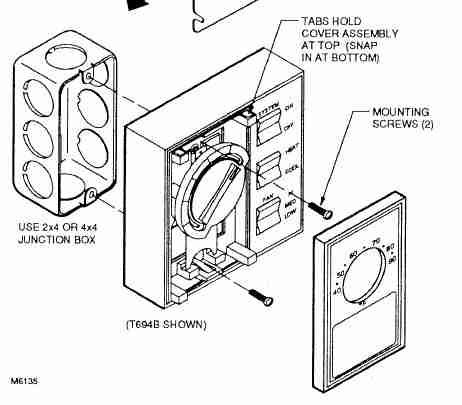 The typical wiring connections for older, non-programmable line voltage thermostats is described ain Honeywell's T451A, T651A, T694A,B,D,F Light Duty Line Voltage Thermostats from which we excerpt and adapt some advice from Honeywell:
The typical wiring connections for older, non-programmable line voltage thermostats is described ain Honeywell's T451A, T651A, T694A,B,D,F Light Duty Line Voltage Thermostats from which we excerpt and adapt some advice from Honeywell:
Watch out: disconnect all electrical power before making any electrical connections, tests, or even touching wiring on line voltage thermostat systems.
While some old timers figure out wiring by shorting thermostat wires together, that is imaginable only for low-voltage thermostat systems.
Touching live line voltage wires risks death by electrocution as well as fire, shock, and equipment damage.
Watch out: Before attempting to install your heater, verify that the power supply wires are the same voltage as the heater you are installing. The best way to check for proper voltage is by using a voltmeter, testing between supply line 1 and 2. 240 and 120 Volt heaters are not interchangeable.
Connecting a 120 Volt heater to a 240 Volt circuit will destroy the heater, could cause fire damage, personal injury or death, and, voids all warranties. - King Electric, cited below.
- Use copper wire only with line voltage thermostats. All wiring must comply with the applicable electrical codes for your area.
- Check specifications: Make sure that the line voltage thermostat electrical rating is sufficient for the current requirements of the equipment it will control. Check voltage, amperage, and wattage. For example,
Watch Out: be sure to check the total wattage of heating equipment that you are going to be switching against the capacity limits of the programmable (or non-programmable) line voltage wall thermostat you plan to purchase and install. For example the Lux PLSPLV512 we recommended above is rated to control 1900 to 3800 watts.
- Use a proper electrical box for mounting: because line voltage thermostats are using 120V or 240V wiring connections, don't just run wires through a wall into the thermostat. Line voltage thermostats usually include a suitable faceplate to cover the junction box mounted in the wall.
Illustration above left, showing typical mounting of a line voltage room thermostat onto an electrical box, courtesy Honeywell Corporation [5].
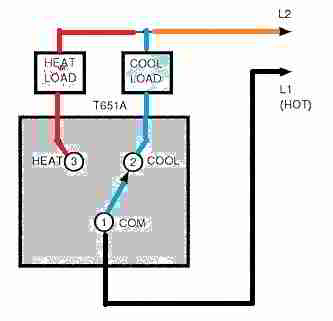
- Connect the equipment wiring (the 120V 240V wires) to the proper terminals at the rear of the thermostat before trying to mount the thermostat to the wall.
For a heat-only application the wiring will be simple as there are just two wires, the L1-hot wire and the L2 heat or load wire.
For a heating + cooling application there will be a heat load wire and a cool load wire (see illustration above left) one of which will be fed by the thermostat depending on whether it is in heating or cooling mode.
See this older 1949 Honeywell Control Handbook [PDF] for an explanation of older line voltage (120-Volt) and 24-Volt thermostats and other controls such as the T40 series 4-wire 120V T44 Thermostat
The installation manual for your particular line voltage room thermostat will include connections for additional wires that may be necessary when the thermostat is being use in more complex installations such as connections to a winter-summer changeover switch, connections to control a separate blower fan motor, etc. - Op. Cit.
Honeywell T451A, T651A, T694A,B,D,F Light Duty Line Voltage Thermostat Wiring Instructions
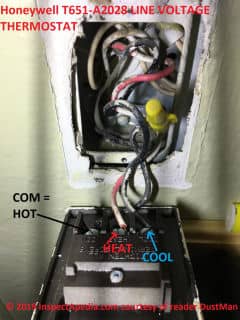 Question: I want to replace a Honeywell T651-A2028 thermostat that controls heating & cooling
Question: I want to replace a Honeywell T651-A2028 thermostat that controls heating & cooling
2019/11/02 DustMan said:
I have a Honeywell T651-A2028 and I want to replace it. I think it has a unique wiring setup that I cannot understand.
There are 3 wires connected to it, 1 has 120v (COM) and the others have no volts (HEAT & COOL).
My apartment complex has very old radiators that have constant supply of hot water in the winter and cold water in the summer. The thermostat only controls the power to the fan at each radiator.
When the apartment complex switches from hot to cold or vice versa they somehow change the wiring so the thermostat can cool or heat appropriately. What are my options for replacements?
Reply: Select the right line voltage thermostat replacement model
Dusty
Thank you for the photo and question - interesting and helpful to other readers.
Above on this page you'll see a very simple line voltage thermostat wiring diagram [image file] that matches your thermostat exactly.
To replace an older Honeywell T652-A2028 line voltage thermostat, the company sells a line of replacement "light duty" line voltage thermostats that can match the functions and wiring of your original unit.
Watch out: Select the right thermostat replacement model.
You'll see that if you select a thermostat that supports both heating and cooling modes, the replacement line voltage 'stats have the identical terminals as those shown your photo of the Honeywell T651-A2028 - that is, COM (common), HEAT, and COOL.
From your description, you are replacing a fan coil heating / cooling unit thermostat. All your thermostat is doing is switching the fan motor on and off in response to a call for heat (in HEAT mode) or a call for cooling (in COOL mode).
I suspect from your note that the model you want is the Honeywell T651A3018 as that thermostat is listed as replacing the Honeywell T451A1264 T451B1008 T451B1024 T451B1032 T451B1057 T451B1065 T451B1073 T451B1081 T651A1269 T651A2028 T651A3000 units.
See HONEYWELL LINE VOLTAGE THERMOSTATS (light duty) SELECTION & WIRING GUIDE [PDF] (cited in detail below) for wiring instructions for current or replacement line voltage thermostats, including the T451A, T651A, T694A,B,D,F Light Duty Line Voltage Thermostat. The company explains that
T451, T651, T694 Thermostats provide on-off control of valves, fans, motors, contactors, electric heat elements, duct furnaces and fan coil units in heating/cooling systems. Switching subbases provide manual control of heating, cooling and fan.
The table above on this page at LINE VOLTAGE THERMOSTATS for HEAT + COOL is a line voltage thermostat selection guide from Honeywell's document
In essence the thermostat is switching on a heating or cooling circuit depending on room temperature and the thermostat's front switch mode settings (HEAT COOL)
Below is just one example wiring diagram of several given in the selection and wiring guide I just cited. Your wiring situation is simpler.
Watch out: your thermostat model and wiring requirements may differ; be sure to read the wiring instructions for your heating & cooling equipment and from the thermostat's manufacturer.
Also if you are not trained in safe, code-compliant, electrical wiring do not attempt any electrical work - hire a professional instead; making a mistake could result in fire, injury, or worse.
Reader Question: how do I connect the wires for a Honeywell Line Volt Pro 8000 thermostat?
I just bought the Honeywell line volt pro 8000.
Attached to the thermostat are two black wires and two red wires...however, coming out of my wall from my old thermostat are green, blue, white and red wires.
Can you help me with what I connect to what? - M.B. 6/18/2014
Reply: Honeywell LineVoltPRO™ wiring information
If you've lost the wiring instructions for the thermostat you're wiring let me know and we'll help dig up that information
Reader follow-up:
I have the instruction book, but I do not see how I am supposed to connect the two black wires and two red wires on the back of the thermostat and the green, blue, white and red wires coming out from the wall.
Reply: Honeywell Line Volt Pro 8000 instructions
I attach an image from Honeywell's Line Volt Pro 8000 instructions (source cited below) - but I do NOT know if this is exactly the model of thermostat you purchased.
Generic thermostat wire codes are described at
THERMOSTAT WIRING COLOR CODES
where G W R B wires are identified.
Watch out: Your reference to color codes makes me worry that you are trying to install a line voltage (120V or 240V AC) thermostat intended to control an electric baseboard heater where previously you had a low-voltage 24V wall thermostat that turned a heating boiler or furnace on and off,
BECAUSE the thermostat you are describing is used to wire electric baseboard heaters NOT to turn on and off a furnace or boiler.
The instructions for your line thermostat should identify each of the thermostat's wires.
Honeywell's instructions identify four wires, 2 black (connect to the LINE terminals of the electric baseboard heater - the incoming power) and 2 white wires (connecting to the LOAD terminals of the electric baseboard heater).
Honeywell says that the wiring hookup details are on the back of the unit's power module. If you don't see that data you can also call Honeywell's tech support line at
800-468-1502
Here are comments from a product review of the Honeywell LineVoltPRO™ electric heater thermostat control
Use a volt meter, your dealing with 240V!! Turn OFF breaker... read diagram on instructions carefully.. the wires on thermostat to connect to load are NOT top top to load but rather top and bottom to load. ... - 7/3/2014 retrieved from Amazon.com product reviews for this thermostat
Other product review comments warn that the device is very heat sensitive and its location should be chosen carefully.
Honeywell LineVoltPRO™ Installation Wiring Instructions for the TL8230A1003 - TL7130A/TL7135A/TL8130A/TL7230A/TL7235A/TL8230A Installation Guide - Power Base (Excerpts)
Watch out: Read the entire document
CAUTION:
- Installation must be carried out by a certified electrician and must comply with national and local
electrical codes. - To prevent severe shock or electrocution, always cut the power at the service panel before working
with wiring. - Use this thermostat for resistive loads only.
- Do NOT install the thermostat in an area where it can be exposed to water or rain.
- Avoid locations where there are air drafts (top of staircase, air outlet), dead air spots (behind a
door), direct sunlight or concealed chimney or stove pipes. - For a new installation, choose a location about 5 ft. (1.5 m) above the floor.
- Install the thermostat on an inside wall facing the heating system.
- Install the thermostat onto an electrical box.
- Keep the thermostat's top and bottom air vents (openings) clean and unobstructed at all times
- Use special CO/ALR solderless connectors if you connect the thermostat to aluminum wires. [Sic - we don't agree as you'll read below]
Watch out: do NOT use CO/ALR - this statement from Honeywell is obsolete and is no longer safe advice. There are, however, safe and approved aluminum wiring repair methods that you can use.
See ALUMINUM WIRING HAZARDS & REPAIRS for advice about proper and US CPSC recommended repairs for aluminum electrical wiring, and see these warnings
about ALUMINUM WIRING REPAIR COALR & CU-AL
Excerpt adapted from Honeywell's instructions for the Line Volt Pro - retrieved 7/3/2014, original source https://customer.honeywell.com/resources/techlit/TechLitDocuments/69-0000s/69-1804EFS.pdf
How to Wire a Marley D26 Electric Heat Wall Thermostat to a 240VAC Circuit & Baseboard
Our photos and wiring diagram for a Marley D-26 wall-mounted line-voltage thermostat illustrate how this simple 240VAC thermostat is wired to the electric baseboard heater.
In short, the red wires from the switch connect, one-each, to each of the incoming 240VAC line voltage wires of the heating circuit.
The black wires from the switch connect to the two wires or terminals from the electric baseboard.
Above and below, the front and back of a Marley MD-26 wall-mounted line-voltage thermostat used with electric baseboard heat.
[Click to enlarge any image]
Watch out: Turn off power source to the heater before attempting installation, maintenance or repairs. Lock, tape or tag circuit breaker or fuse so that power cannot be turned on by accident.
Failure to do so could result in serious electrical shock, burns or possible death. - Op. Cit.
Below: wiring diagram, adapted from the manufacturer's packing illustration, shows how a a Marley D-26 wall-mounted line-voltage thermostat illustrate how this 240VAC thermostat is wired to the electric baseboard heater.
Watch out: Before attempting to install your heater, verify that the power supply wires are the same voltage as the heater you are installing.
The best way to check for proper voltage is by using a voltmeter, testing between supply line 1 and 2. 240 and 120 Volt heaters are not interchangeable.
Connecting a 240 Volt heater to a 120 Volt circuit will reduce the wattage 75% making the heater feel barely warm.
Connecting a 120 Volt heater to a 240 Volt circuit will destroy the heater, could cause fire damage, personal injury or death, and, voids all warranties. - King Electric, cited below.
Wiring Programmable Line Voltage Heat-Only Hemostats
Other Honeywell line voltage thermostats and line voltage thermostats from other manufacturers, however should work fine where you want to add thermostat programmability, automatic setbacks, etc.
Examples of modern line-voltage programmable room thermostats include:
Honeywell TL8130A1005 - for electric baseboards and fan-forced heaters. (This is a single-function or "heat only" single-pole-single-throw (SPST) thermostat. Approximate Price: $50. U.S. designed to control 240V heating equipment.
Honeywell YTL9160AR1000 - line voltage, heat only, for electric baseboard or fan convector or fan-forced heaters, is an interesting development in wireless thermostats.
The kit includes a Wireless EConnect programmable wall thermostat and one Electric Heating Equipment Interface Module (EHEIM). Each EHEIM can support a maximum load of 3000W at 240V - figure $150. U.S.
The Honeywell EConnect™ TL9160AR is shown above.
Honeywell's EConnect™ wireless thermostats can accept up to 8 EIMs on a single thermostat - sketch below right.
Honeywell EConnect™ wireless thermostats can control multiple electric heating baseboard units but only up to a total amperage load specified by the manufacturer, e.g. 12.5A - sketch, below [6]
Also see the King electronic programmable thermostats cited below on this page.
Honeywell line voltage thermostat connections
Line Voltage Thermostat, Heating Only Digital Programmable, Switch Type DPST, Switch Action Open on Rise, Number of Switches 1, Sensor Type Thermistor, Digital 7 Day Programmable, 15 Amps Max; 3600 Watts at 240 VAC, 3120 Watts at 208 VAC, For Use With Electric baseboards, convectors and fan forced heaters (resistive rated loads), Color White, Application Heating, 7 Programs per Week, Digital LCD Display, 208-240, 208-240, -, -, 15, 15, 15, 2, UL, CSA
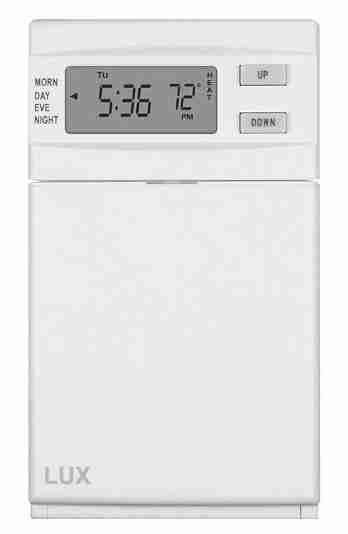
Lux PSPLV512 - 120V or 240V programmable wall thermostat intended for electric baseboard or radiant type electric heat, about $50. U.S.
Lux Luxpro Programmable Line Voltage Thermostat -( $70. U.S.) 120/240V SPST 1,900W at 120VAC (non inductive). 3,800W at 240VAC (noninductive).
[Illustrated above]
Radimo Radistat-Pro, line voltage 120/240V thermostat intended for electric radiant floor heating ($120) available through Sears
This thermostat, or its double, appears under a range of name brands, so we suspect they're all the same product sold with re-branding as Radimo. Laticrete, etc
Dayton's line voltage room thermostat shown here is the Dayton 1UHG4 heating-only digital, programmable room thermostat suitable for electric heat control. About $57. U.S.
Specifications from granger.com include:
Line Voltage Thermostat, 5+1+1 Programmable, Switch Type SPST, Switch Action Open / Close on Rise, Number Of Switches 1, Control Range 41-95 F, Differential +/- 1 Deg F, Height 4 1/4 In, Width 3 5/8 In, Depth 1 1/4 In, Temp Sensitivity +/- 1 Deg F, Sensor Type NTC Thermistor, For Use With Heat Only, Color White, Application Programming 5+1+1, LCD Display, Enclosure Type PVC, Includes Screws and Mounting Plate
Trane also produces a range of line voltage thermostats (Trane Line Voltage Thermostat M TC126 004 NIB, Trane TX 126 004, Trane T4039M1095, Trane THT0567) and programmable thermostats (ComfortLink™II, Trane XL900-XL200 compatible with 24-V systems when a 24-V relay accessory panel is added), with more information from from Trane.
Trane's wide array of electric unit heaters (wall mounted, ceiling suspended & others) include some models that can be operated from a room thermostat (24V WD1 or WD2 controlling 240V heaters or WD3/WD4 120V control operating 240V heaters with additional line voltage and 600-volt controllers available). [7]
Wiring Line Voltage Thermostats for both Heating & Cooling
 Honeywell T6052A1015 - heating or cooling, but not programmable, SPDT thermostat.
Honeywell T6052A1015 - heating or cooling, but not programmable, SPDT thermostat.
About $140. U.S. Supports 2-stage heat and 2-stage cooling.
An older T652-A2028 line voltage thermostat, shown in our reader's photo here, can be replaced by one of Honeywell's newer light duty line voltage thermostats such as the Honeywell T694D2009 but
Watch out: there are several models of line voltage thermostats supporting both heating and cooling from which to select depending on your application.
Be sure to read the instructions from the manufacturer of your heating and cooling equipment as well as the Honeywell company's guidance in the Honeywell reference we cite below.
An example wiring diagram, one of several - so this may not be the right wiring for your equipment - is shown below.
- HONEYWELL FAN COIL THERMOSTAT T6169 MANUAL [PDF] (2001) retrieved 2020/01/16 original source: https://customer.honeywell.com/resources/Techlit/TechLitDocuments/95C-00000s/95C-10679.pdf
Excerpt: The T6169 thermostats control line voltage valves an/or blower motors on Fan Coil units in manual or automatic changeover, cooling, heating or cooling/heating systems.
These thermostats feature single fan an/or system manual switches. - HONEYWELL LINE VOLTAGE THERMOSTATS (light duty) [PDF] Honeywell Corporation,
Honeywell Inc. Home and Building Control USA: 1985 Douglas Drive North 740 Ellesmere Road Golden Valley, MN 55422 USA
&
Home and Building Control Canada: Honeywell Limited—Honeywell Limitée Scarborough, Ontario M1P 2V Canada, retrieved 2019/11/02, original source: customer.honeywell.com/resources/techlit/TechLitDocuments/63-0000s/63-2051.pdf
Honeywell notes that the company has " offices in all principal cities of the world. Manufacturing in Australia, Canada, Finland, France, Germany, Japan, Mexico, Netherlands, Spain, Taiwan, United Kingdom, U.S.A."
[Click to enlarge any image]
Below: an excerpt from Honeywell's replacement line voltage thermostat guide describing the T451- T651- and T694- series light duty line voltage thermostats and thermostat selection options.
Wiring diagrams and examples for these replacement thermostats are in the reference cited above and are described as well,
at LINE VOLTAGE THERMOSTAT WIRING
Troubleshooting a King ES230 thermostat for electric heat control
A few months ago we installed an ES230-R 240/208 Volt Digital Thermostat to control 2 King electric wall heaters. At bedtime we turn the thermostat down to 62 from 72.
Occasionally, when we go to turn the thermostat up for the day, it will be reading "88".
By pressing on the up button for a few seconds, I can turn it up to 72 and it will work fine. Can this happen if the house temperature went below 62 during the night?
This question and reply were posted originally
Reply:
The King ES230 electric heat thermostat, in default mode, should be displaying the current room temperature.
[ Shown: the King ES-230 line voltage non-programmable wall thermostat used to control electric heat.
When you press an up or down key, a thermometer appears in the display, and you can then further press up or down keys to change the SET temperature for the room.
If your thermostat is reading 88 degF before you touch it, it thinks that's the room temperature.
A thermostat might read higher than the actual room temperature for a number of reasons such as where it is located, exposure to sunlight or to another heat source.
I would start by making an independent check of the room temperature, maybe mounting a simple thermometer right next to your wall thermostat.
If you find that the thermostat is calling for heat and is warming the room when you have it set below the current room temperature then I suspect either a wiring error or a defective thermostat.
Below is a wiring schematic for the King ES-230 line voltage thermostat along with links to more information about installing and wiring this electric heat thermostat.
How to Wire a Built In Thermostat on Electric Baseboard Heaters
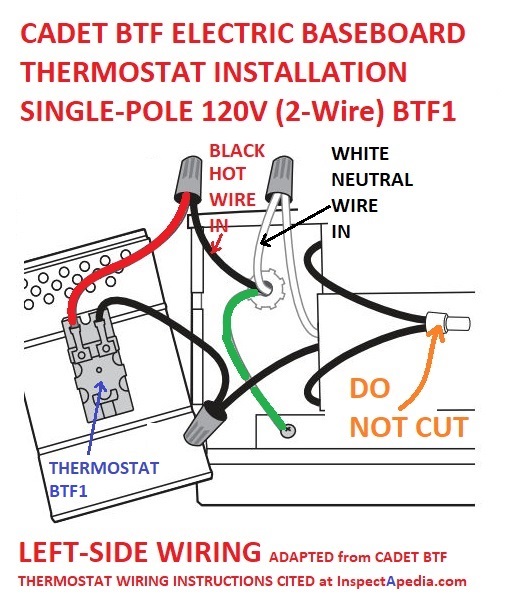 These illustrations and examples of wiring the built-in thermostat found at either end of some electric baseboard heaters are adapted from
These illustrations and examples of wiring the built-in thermostat found at either end of some electric baseboard heaters are adapted from
CADET BTF-SERIES ELECTRIC BASEBOARD THERMOSTAT MANUAL [PDF] (2017) cited along with company contact information at the end of this article.
- Example 1 shown here describes simple wiring connections for a single pole 2-wire 120-Volt electric heating baseboard circuit with the Cadet BTF-1 thermostat at the baseboard's left end. If wiring at the right end of the baseboard the connections are about the same but the thermostat is flipped 180 degrees.
Watch out: these instructions are only an example; your specific heater, electrical circuit, and control wiring details will vary by electric baseboard heat or convector heater fan unit manufacturer, brand, and model of both the heater and the thermostat.
Watch out: Be SURE to find and read the instructions provided by the manufacturer.
Watch out: And DO NOT try any electrical wiring or installation if you are not trained to do so safely, as making a mistake can result in fire, injury, or death. You can be shocked or killed.
In some building code jurisdictions these installations must be made by a licensed electrician.
Other models of Cadet electric heater thermostats and their instructions are provided by the company and instructions for other electric heat thermostat brands and heating convector thermostat controls are listed
at LINE VOLTAGE THERMOSTAT INSTALLATION INSTRUCTIONS by BRAND & MODEL
Instead of running wires through a building wall or other cavities to control electric baseboard heaters many units incorporate the heating thermostat in one end of the heating baseboard itself.
In addition, as long as the total heating load does not overload the electrical circuit ampacity rating and does not overload the baseboard heater thermostat ampacity rating (typically about 20 Amps) it is often possible to use the baseboard heat thermostat to control multiple electric baseboards (typically all in the same building room or area).
The electric baseboard control thermostat is mounted at either end of the first electric baseboard unit in the series (if more than one is to be installed) and is put at the end of the heater to which the powering electrical circuit has been brought.
- Example 2: the illustration below shows wiring connections for a single pole 2-wire 208/240-Volt electric baseboard heat circuit, adapted from Cadet's BTF-1 heater instructions.
Notice that on this 2-wire (nominal 240VAC) circuit, often the wire colors are black and white but the white wire is marked with a bit of black tape to make clear that it is a HOT wire, not a neutral wire.
Both of the baseboard heat thermostat wiring illustrations above are called "single pole" installations because the thermostat actually switches on or off just a single wire - the hot or black wire.
- Example 3 Below shows shows wiring connections for a double- pole 4-wire 208/240-Volt electric baseboard heat circuit, adapted from Cadet's BTF-2 heater instructions.
Notice that this is a different thermostat, employing a double pole switch. The switch itself sports four wires: 2 red and 2 black that must be connected by following the company's detailed instructions - those provide additional information beyond these sketches.
Again notice that there are just two incoming hot wires in this 240VAC circuit, 1 black (hot or Line 1) and 1 white (also hot, or Line 2, marked as "hot" with a bit of black electrical tape).
The instructions for wiring both BTF-1 (single pole) and BTF-2 (double pole) electric baseboard thermostats provide details for additional wiring situations including:
- Double Pole (4-Wire) BTF-2 Electric Baseboard Heat Thermostat on a 240-Volt circuit as we illustrated immediately above, but feeding a second heating baseboard "downstream" from the first one
- Single Pole (2-Wire) BTF-1 Electric Baseboard Heat Thermostat on a 120-Volt circuit illustrated earlier above, but feeding a second heating baseboard "downstream" from the first o
- Double Pole (4-Wire) BTF-2 Electric Baseboard Heat Thermostat on a 120-Volt circuit rather than on a 240V circuit
Hook up a wall plug on an electric heat circuit?
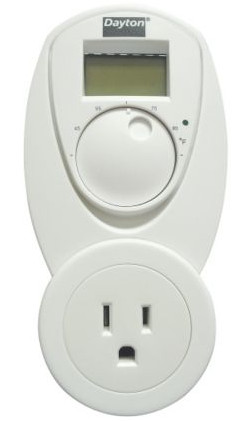 Reader question: I want to add a 120V electrical outlet and noticed that we already have wiring for electric baseboard heat. Is there a way to use that circuit to add a wall plug?
Reader question: I want to add a 120V electrical outlet and noticed that we already have wiring for electric baseboard heat. Is there a way to use that circuit to add a wall plug?
Reply: no but you can install a wall electrical receptacle to control a portable electric heater
Interestingly when first asked about this I said I didn't think so, out of concern that there may be no neutral wire or ground wire suitable for wiring an electrical receptacle or "wall plug" up to an electric baseboard heat circuit.
Watch out: and indeed, normally you would not be able to safely wire a 120V wall receptacle into the 240V circuit that controls electric baseboard heat since that circuit may be missing a suitable neutral and ground wire.
See ELECTRICAL OUTLET, HOW TO ADD & WIRE.
But in researching wall thermostats we came across the combination line voltage wall thermostat for electric heat and wall receptacle combination shown in our photo (left).
This device is sold by Dayton, Model 1UHG6 and is intended to control electric heat as well as to provide an electrical outlet plug. Sold by grainger.com who includes these specifications:
- Line Voltage Control, Outlet Plug Thermostat, Switch Type SPST, Switch Action Open On Rise, Number Of Switches 1, Control Range 40-95 F, Differential +/- 1 Deg F,
Height 5 1/2 In, Width 2 7/8 In, Depth 2 5/8 In, Temp Sensitivity +/- 1 Deg F, Sensor Type NTC Thermistor,
For Use With Portable Heaters [italics ours], Color White, Application Heating Only, LCD Di
splay, Enclosure Type PVC - about $60. U.S.
So let's get clear just what this is: this is not an electrical outlet that you add to one leg of the 120V or 240V circuit that controls built-in electric baseboard heat.
This is a device that is installed in the wall where a conventional electrical receptacle would have been installed.
Dayton's 1UHG6 is, however a neat device. It is a wall thermostat that is intended to control a portable electric heater that is plugged into the wall where this device is installed.
You might note that the wall thermostat may be a bit low on the wall and you won't want it too close to the heater itself or it'll be dominated by heat local to the heater.
Nevertheless it's a possible way to make your portable electric heater thermostatically controlled.
Question: electric wall heater turned itself on when the thermostat was not calling for heat
My electric wall heater turned itself on last night. The thermostat was off or not set to a temp. During spring and summer I have my couch in front of it bc I don't use it. During the winter I arrange my apt accordingly to have proper clearance. But tonight I heard it running and I thought that was weird.
I pulled my couch away and saw that the screen was literally red instead of white. I'm guessing it was too hot especially with my couch right up against it. So I turned it off from the breaker since at the point I couldn't turn the dial off anymore than it was.
To turn it on I have to turn it above 50 degrees. Under 50 means its off. And it has been off since the end of winter. My place stays warmer than by itself so it should never cut on. Not sure why this happened. Just looking for any help. Bc had I not checked on it it could have caught fire.
Reply:
Watch out: this sounds like a dangerous condition. If your electric wall heater came on while the thermostat was in the OFF position then your unit probably has either a bad internal switch, thermostat, or short circuit in the thermostat or control wiring. As you suggest, the unit is unsafe and should not be used before it is repaired or replaced.
And indeed, a couch, curtains, or other combustibles should never be placed in front of an electric heater exactly because of the overheating and fire risk that you observed. Thank goodness you detected the condition and turned off power to the heater. Had no one been at home, or had people been asleep the result could have been a fatal fire.
Can you tell me the brand and model of the heater?
And if you can send photos of the heater and any labeling on the unit, please do so using the CONTACT link found at top, left, or bottom of our web pages.
Line Voltage Thermostat Installation & Wiring Guides
Illustration: a wiring table for the Honeywell TB6575A line voltage thermostat - whose manual is given below as a PDF download.
- Aube Thermostats contact: Aube Products, 705 Montrichard Avenue Saint-Jean-sur-Richelieu, Quebec J2X 5K8 Canada Tel.: (450) 358-4600
Toll-free: 1-800-831-AUBE
Fax: (450) 358-4650 Email: aube.service@honeywell.com - AUBE RC840T THERMOSTAT INSTALLATION INSTRUCTIONS [PDF] - retrieved 2017/01/29, original source: http://www.aubetech.com/manuel/2/RC840T.pdf also available from Honeywell Corporation.
- AUBE RC840T ELECTRIC HEATER SWITCHING RELAY INSTRUCTIONS [PDF] (2017/1/07)
- AUBE RC840T ELECTRIC HEATER SWITCHING RELAY INSTRUCTIONS [PDF] (2011/01/17) Older Instructions:
- AUBE RC840 ELECTRIC HEATER SWITCHING RELAY INSTRUCTIONS [PDF] Op. Cit. This relay is like the RC840T but does NOT include a built-in low voltage transformer.
- Aube TH106 PROGRAMMABLE THERMOSTAT USER GUIDE [PDF] (2005) line voltage, electric heater such as electric baseboard
Excerpt:
This programmable thermostat can be used to control an electric heating system such as an electric baseboard heater, a radiant ceiling, a radiant floor, a convector, etc. - Aube TH107 THERMOSTAT USER GUIDE [PDF] (2005)
- Aube TH115 A/F/AF LINE VOLTAGE THERMOSTAT MANUAL [PDF] (2005) 120VAC & 240VAC line voltatge heater thermostat
- BROAN / NUTONE LINE VOLTAGE THERMOSTAT INSTALLATION INSTRUCTIONS [PDF] Broan-Nutone LLC, a Nortek Company, 926 W. State Ste. Hartford WI 53027 USA / NuTone, Inc., also a Nortek Company, Madison & Red Banksd Roads, Cincinnati, OH 45227, USA
- CADET HEATER MANUALS & CADER / ENCORE HEATER RECALL - Cadet Heater Manuals & Cadet Heater Recall Notice
- CADET BTF-SERIES ELECTRIC BASEBOARD THERMOSTAT MANUAL [PDF] (2017) Cadet Heaters, PO Box 1675, Vancouver WA 98668, Tel: 1-360-683-1675 Website: www.cadetheat.com Technical Support Call: 855-223-3887
Other models of Cadet electric heater thermostats and their instructions are provided by the company at http://cadetheat.com/support/install-help
Cadet's electric baseboard wiring instructions cover all of the common wiring situations - summarized in our table at
- CADET SBFT2 ELECTRIC BASEBOARD HEATER BUILT-IN THERMOSTAT MANUAL [PDF] Op. Cit.
- COLUMBUS ELECTRIC ET-SERIES LINE VONLAGE THERMOSTAT INSTALLATION [PDF] (older models) Columbus Electric Division of TPI, PO Box 4973, Johnson City, TN 37602 USA Tel 800-251-7828
- COLUMBUS ELECTRIC ET9-Series LINE VOLTAGE THERMOSTAT INSTALLATION, [PDF] TPI Corporation, Website: www.tpicorp.com, Tell: 1-800-682-3398. The company's current product lines include Markel Products, Raywall, and Fostoria and a very large range of HVAC equipment and controls. Retrieved 2018/07/25, original source: http://www.kele.com/Catalog/22%20Thermostats_Controllers/PDFs/ET9%20Series%20Installation.pdf
Excerpt:
The Columbus Electric wall mounted line voltage thermostat is suitable for direct connection with any resistance heating elements and unit heaters.
This thermostat has a snap action switch operated by a bimetal actuator and is available in single pole, double pole with positive off, two stage heat.
Cooling only and heat or cool models. Other options include a built in thermometer and/or 6 inch wire leads. - COLUMBUS ELECTRIC EPET SERIES EXPLOSION-PROOF THERMOSTATS INSTALLATION [PDF]
Excerpt:
The Columbus Electric EPET Series thermostat is designed to control heating only, cooling only, heating and cooling or ventilation systems in oil refineries, grain elevators, munitions plants, hospital operating rooms and other hazardous locations. - COLUMBUS ELECTRIC UT THERMOSTAT INSTALLATION [PDF] (2004) Columbus Electric Division of TPI, PO Box 4973, Johnson City, TN 37602 USA Tel 800-251-7828, Fax 423-477-0545
- Dayton LINE VOLTAGE THERMOSTATS OPERATING INSTRUCTIONS [PDF] Models: 1UHH1 thru 1UHH4, 2NNR5 thru 2NNR9, 2NNT1 thru 2NNT5, and 6EDY3 thru 6EDY7, 2NNR7
Excerpt:
These Line Voltage Thermostats are designed for reliable use in heating, ventilating, and refrigeration applications. A broad temperature range between -30° and +120°F (-34° and +49°C) allows for a wide range of heating, ventilating, and refrigeration applications. Snap-acting contacts are in a dust protected enclosure. SPDT switches are enclosed and protected.
- EMERSON / WHITE-RODGERS Line Voltage Mechanical Thermostat: 1RC43C [PDF] - refrigeration tempeature control, 1RC43
- Functional Devices, 24-V Switching Relay, RIB2401B, enclosed relay, 20 amp SPDT with 24 VAC/DC/120 VAC coil. Made in United States by Functional Devices, Inc. 101 Commerce Drive, PO Box 437 Sharpsville, IN 46068 USA, Tel: (800) 888-5538, Technical Support: support@functionaldevices.com or Sales: sales@functionaldevices.com
- HONEYWELL FAN COIL THERMOSTAT QUICK REFERENCE GUIDE - CROSS REFERENCE CARD [PDF] Honeywell Controls, retrieved 2020/01/16 original source: https://customer.honeywell.com/resources/Techlit/TechLitDocuments/67-0000s/67-7080GW.pdf
- HONEYWELL COMMERCIAL THERMOSTAT APPLICATION SELECTION & CROSS REFERENCE GUIDE [PDF] Honeywell Controls, retrieved 2020/01/16 original source: https://customer.honeywell.com/resources/Techlit/TechLitDocuments/63-0000s/63-96
- HONEYWELL T451, T651 MOTOR-RATED P:RECISION THERMOSTATS [PDF] (2001)
Honeywell Inc. Home and Building Control USA: 1985 Douglas Drive North 740 Ellesmere Road Golden Valley, MN 55422 USA
Home and Building Control Canada: Honeywell Limited—Honeywell Limitée Scarborough, Ontario M1P 2V Canada,
Excerpt: The T651 thermostat provides direct, accurate line voltage control of inductively-rated heating, ventilating, or cooling equipment used in commercial or industrial environments.
The T451 provides precision line voltage control of motor rated electric, gas or oil heating equipment.
- HONEYWELL T451A, T651A, T694A,B,D,F LINE VOLTAGE THERMOSTATS (light duty) SELECTION & WIRING GUIDE [PDF] (1992) Honeywell Corporation,Op. Cit.,
retrieved 2019/11/02, original source: customer.honeywell.com/resources/techlit/TechLitDocuments/63-0000s/63-2051.pdf
Excerpt: T451, T651, T694 Thermostats provide on-off control of valves, fans, motors, contactors, electric heat elements, duct furnaces and fan coil units in heating/cooling systems.
Switching subbases provide manual control of heating, cooling and fan. - HONEYWELL T451 - T651 LINE VOLTAGE THERMOSTAT PRODUCT CROSS REFERENCE [PDF] indicates which older thermostat models are replaced by the T451 or T641 model.\
Above and below: the Honeywell TB6575A line voltage thermostat used to control heating & cooling fan coil units.
- HONEYWELL TB6575A LINE VOLTAGE THERMOSTAT INSTRUCTIONS [PDF] wiring diagrams, installation instructions for this 3-speed fan coil thermostat
- HONEYWELL TB6575/TB8575 SuitePRO FAN COIL THERMOSTAT Specifications [PDF] Honeywell International Inc.1985 Douglas Drive NorthGolden Valley, MN 55422 USA Email: customer.honeywell.com
Excerpts:
The SuitePRO™ is a family of Digital Fan Coil thermostats for residential and commercial applications such as hotels, condominiums, school classrooms, etc.
All four models are suitable for multiple applications.
Changes in output wiring and external links between wiring terminals allow you to configure the thermostat for the appropriate application.
Valves and auxiliary electric heaters can be controlled using a relay or contactor controlled by the system switch - Honeywell: 1949 HONEYWELL CONTROL HANDBOOK older line voltage (120-Volt) and 24-Volt thermostats and other controls such as the T40 series 4-wire 120V T44 Thermostat
- Johnson Controls, PENN T22/T25/T26 Series LINE VOLTAGE WALL THERMOSTAT (Heating, Cooling,
or Heating and Cooling) [PDF] (2015), Johnson Controls
5757 N. Green Bay Ave.
P.O. Box 591
Milwaukee, WI 53201 USA, Website: www.johnsoncontrols.com retrieved 2019/11/02, original source: https://www.johnsoncontrols.com/-/media/jci/be/united-states/hvac-controls/thermostats/specs/1922255.pdf
Excerpt: For line voltage control of residential, commercial, or industrial heating or year-round air conditioning. Heat or cold anticipators are not required.
- KING ES-230 208/240VAC & 120VAC Electric Heat Thermostat Installation Manual [PDF] Electronic line voltage thermostats, in programmable and non-programmable models supporting 120VAC or 230VAC, King Electrical Mfg. Co., 9131 10th Ave. South, Seattle WA 98108, USA, Tel: 206-762-0400, Website: www.king-electric.com
This thermostat replaces King Thermostat models: CALV/ T4800/ T4700/ T4600/ 1A66/ D22/ S22/ M602/ T498/ T4398/ MD26/ WR661/ 1D22/ S2022/ TW242 /TD902/ T410/ TD942/ M7/ M402/ M512
Watch out: Danger of Electric Shock or Fire Hazard: read all wire sizing, voltage requirements, and safety data to avoid property damage and personal injury. Installation: This line voltage device should be installed and serviced by a qualified electrician.
- MARLEY T-SERIES LINE VOLTAGE THERMOSTAT WIRING [PDF] Marley Electric Baseboard Heaters (integral in the baseboard) Models TA1A Single Break, TA1TP (tamper proof), TA2A Double Break, TA2TPA (tamper proof), Marley Engineered Products, an SPX Company, 470 Beauty Spot Rd. East, Bennetsville, SC 29512, USA
- NEST THERMOSTAT WIRING for 240V HEAT CONTROL [PDF] when using a switching relay / transformer to control an electric heater through a switching relay, using an example from from WarmlyYours.com a radiant heating company.
- RIB2401B 24V SWITCHING RELAY SPECIFICATION SHEET [PDF] retrieved 2020/01/19 original source: /electric/24VAC-Relay-Functional-Devices-RIB2401B-specifications.pdf
- WarmlyYours at 800-875-5285 or at WarmlyYours USA, 590 Telser Rd, Suite B, Lake Zurich, IL, 60047 USA or in Canada at 300 Granton Drive, Unit 4A, Richmond Hill, L4B1H7 Canada, Tel: 800-875-5285.
- WHITE RODGERS 1A10 651 LINE VOLTAGE THERMOSTAT INSTALLATION MANUAL [PDF] Emerson Electric Co. / Emerson Climagte Technologies, ,9797 Reavis Rd., St. Louis MO 63123, USA, Web: white-rodgers.com emersonclimate.com
- White Rodgers Homeowner help line: 1-888-725-9797
Above: White Rodgers 1687-9 SPTD line voltage mechanical thermosatat used for heating and cooling applications.
- WHITE-RODGERS 1609-12 - 1687-9 REFRIGERATION TEMPERATURE CONTROL SPECIFICATIONS [PDF] www.white-rodgers.com
- WHITE RODGERS 1A10-1A16-Series LINE VOLTAGE THERMOSTAT INSTALLATION INSTRUCTIONS [PDF] Emerson Electric Co. / Emerson Climate Technologies, , Web: white-rodgers.com emersonclimate.com
- Also see this EMERSON / WHITE-RODGERS Line Voltage Mechanical Thermostat: 1RC43C [PDF] - refrigeration tempeature control, 1RC43
- Also see WHITE RODGERS CONTROLS & MANUALS - more White Rodgers thermostats and controls
Replace a Line Voltage Thermostat with a Nest® or other Programmable Low-voltage Thermostat
We have moved this discussion to a separate article now found
at CONVERT LINE to LOW VOLTAGE THERMOSTAT
...
...
Continue reading at THERMOSTAT POWER & VOLTAGE or select a topic from the closely-related articles below, or see the complete ARTICLE INDEX.
Or see LINE VOLTAGE THERMOSTAT FAQs - questions & answers posted originally at the end of this page.
Or see these
Recommended Articles
- ARTICLE INDEX to HVAC THERMOSTATS - complete list of thermostat instructions by brand and type
- CONVERT LINE to LOW VOLTAGE THERMOSTAT
- ELECTRIC BASEBOARD HEAT INSTALL
- ELECTRIC HEAT - home
- ELECTRICAL POWER SWITCH FOR HEAT
- FAN COIL & FAN CONVECTOR HEATERS & HYDRONIC COILS - use line voltage thermostats
- LINE VOLTAGE THERMOSTATS - wiring instructions, diagrams, manuals for line voltage thermostats
- MANUALS for HEATING & A/C SYSTEM CONTROLS
- MANUALS & PARTS GUIDES - HVAC - home
- THERMOSTAT POWER & VOLTAGE
- THERMOSTAT WIRE CONNECTIONS - wiring instructions for low voltage thermostats
Suggested citation for this web page
LINE VOLTAGE THERMOSTATS at InspectApedia.com - online encyclopedia of building & environmental inspection, testing, diagnosis, repair, & problem prevention advice.
Or see this
INDEX to RELATED ARTICLES: ARTICLE INDEX to HVAC THERMOSTATS
Or use the SEARCH BOX found below to Ask a Question or Search InspectApedia
Ask a Question or Search InspectApedia
Try the search box just below, or if you prefer, post a question or comment in the Comments box below and we will respond promptly.
Search the InspectApedia website
Note: appearance of your Comment below may be delayed: if your comment contains an image, photograph, web link, or text that looks to the software as if it might be a web link, your posting will appear after it has been approved by a moderator. Apologies for the delay.
Only one image can be added per comment but you can post as many comments, and therefore images, as you like.
You will not receive a notification when a response to your question has been posted.
Please bookmark this page to make it easy for you to check back for our response.
IF above you see "Comment Form is loading comments..." then COMMENT BOX - countable.ca / bawkbox.com IS NOT WORKING.
In any case you are welcome to send an email directly to us at InspectApedia.com at editor@inspectApedia.com
We'll reply to you directly. Please help us help you by noting, in your email, the URL of the InspectApedia page where you wanted to comment.
Citations & References
In addition to any citations in the article above, a full list is available on request.
- [1] Proliphix Corporate Headquarters [Website: proliphix.com] , 3 LAN Drive Suite #100, Westford, MA 01886 Phone: +1.978.692.3375 Toll Free (U.S.): 866-IP-LIVING (866.475.4846) Fax: +1.978.692.3378 - Sales: sales@proliphix.com Marketing: marketing@proliphix.com Customer support: support@proliphix.com http://www.proliphix.com/ - quoting from the company's website:
All Proliphix Network Thermostats come with our free Uniphy Remote Management Service. This unique offering lets you monitor and control your HVAC systems by simply pointing your Browser to our secure Proliphix Web Site. Enjoy the convenience of programming a thermostat from any location, using a simple graphical interface. No computer equipment or software is required. And since Proliphix takes care of the network configuration for you, you’ll be up and running in no time. We’ll even proactively monitor your thermostats and send you an immediate email or SMS message when an HVAC problem is detected. - [2] "The Nest Learning Thermostat", Nest Thermostat, 900 Hansen Way Palo Alto, CA 94304, Tel: 855-4MY-NEST, Email: info@nest.com, website http://www.nest.com/, retrieved 1/24/2013.
- [3] Honeywell Controls, the company wants you to use their contact form at this web page: http://www51.honeywell.com/honeywell/contact-support/contact-us.html
Honeywell Consumer Products, 39 Old Ridgebury Road Danbury, CT 06810-5110 - (203) 830-7800
World Headquarters, Honeywell International Inc., 101 Columbia Road, Morristown, NJ 07962, Phone: (973) 455-2000, Fax: (973) 455-4807 1-800-328-5111 - [4] Honeywell Corporation, Honeywell T451A, T651A, T694A,B,D,F Light Duty Line Voltage Thermostats, [installation, troubleshooting manual], 1992, Honeywell Consumer Products,
39 Old Ridgebury Road Danbury, CT 06810-5110 - (203) 830-7800 copy on file as Honeywell_Line_Voltage_T651A.pdf
World Headquarters, Honeywell International Inc., 101 Columbia Road, Morristown, NJ 07962, Phone: (973) 455-2000, Fax: (973) 455-4807 1-800-328-5111 copy on file as Honeywell_Line_Voltage_T651A.pdf
"T451, T651, T694 Thermostats provide on-off control of valves, fans, motors, contactors, electric heat elements, duct furnaces and fan coil units in heating/cooling systems. Switching sub-bases provide manual control of heating, cooling and fan." - [5] Honeywell Corporation, "Honeywell Thermostats", website http://www.honeywell-thermostat.com/line-voltage.html retrieved 3/16/13
- [6] Honeywell EConnect™ Wireless Thermostat Kit TL9160AR System Installation Guide, retrieved 3/15/13, copy on file as Honeywell_EConnect69-2474EFS.pdf
- [7] Trane, Ingersoll Rand Residential Solutions, Trane PO Box 9010, Tyler TX 75711, Website www.trane.com
- [8-10 pending]
- [11] White Rodgers Thermostats and HVAC controls,
Homeowner information: http://www.emersonclimate.com/en-US/brands/white_rodgers/Pages/wr-homeowner-info.aspx
Contractor information: http://www.emersonclimate.com/en-US/brands/white_rodgers/wr_contractor_info/Pages/white-rodgers-contractor-info.aspx
White Rodgers Product Catalog (don't misspell the company's name as White Rogers Thermostats) -
http://www.emersonclimate.com/Documents/thermostats.pdf - Thermostat Catalog - [14] Hunter Fan 2500 Frisco Ave. Memphis, TN 38114 888-830-1326 www.hunterfan.com
- [15] Trane TCONT800 Series Touch Screen Programmable Comfort Control Ownes Guide, American Standard, Inc., Troup Highway, Tyler TX 75711, January 2005, Telephone: Customer Service: 1-877-3381, website: www.trane.com
- In addition to citations & references found in this article, see the research citations given at the end of the related articles found at our suggested
CONTINUE READING or RECOMMENDED ARTICLES.
- Carson, Dunlop & Associates Ltd., 120 Carlton Street Suite 407, Toronto ON M5A 4K2. Tel: (416) 964-9415 1-800-268-7070 Email: info@carsondunlop.com. Alan Carson is a past president of ASHI, the American Society of Home Inspectors.
Thanks to Alan Carson and Bob Dunlop, for permission for InspectAPedia to use text excerpts from The HOME REFERENCE BOOK - the Encyclopedia of Homes and to use illustrations from The ILLUSTRATED HOME .
Carson Dunlop Associates provides extensive home inspection education and report writing material. In gratitude we provide links to tsome Carson Dunlop Associates products and services.


